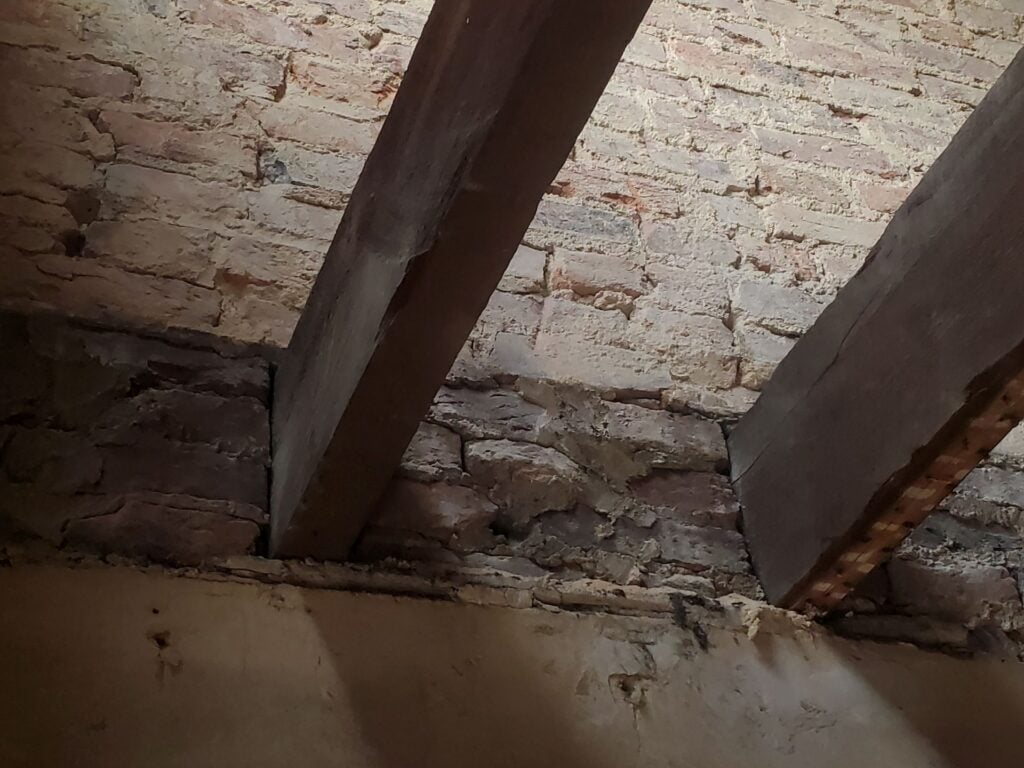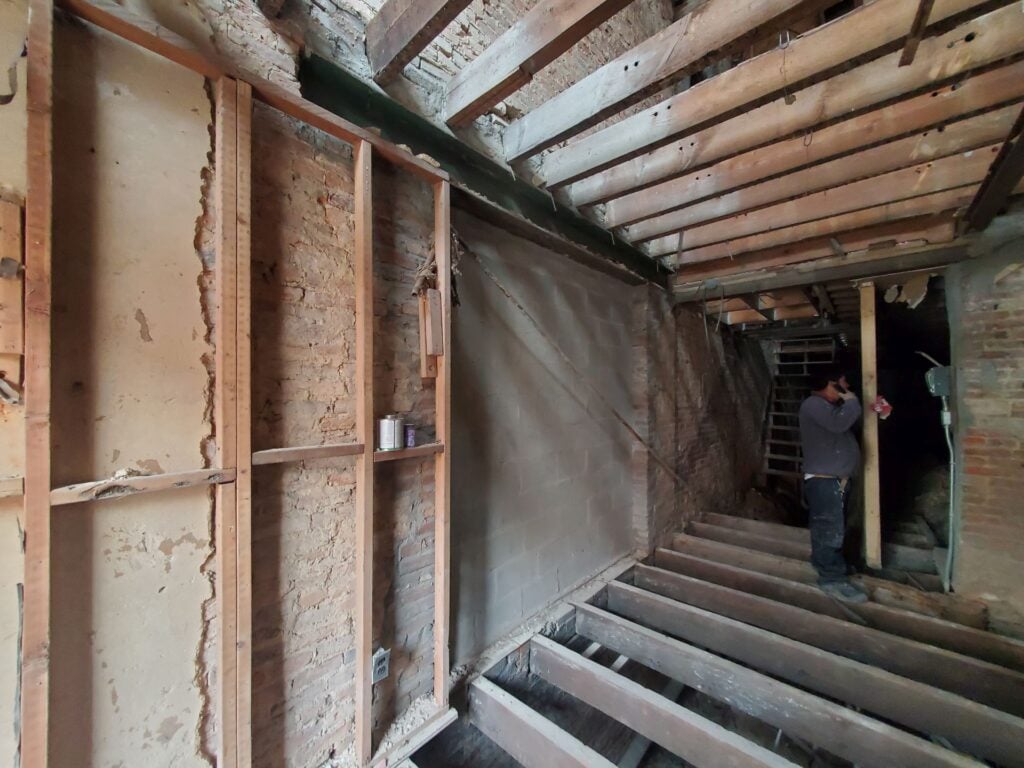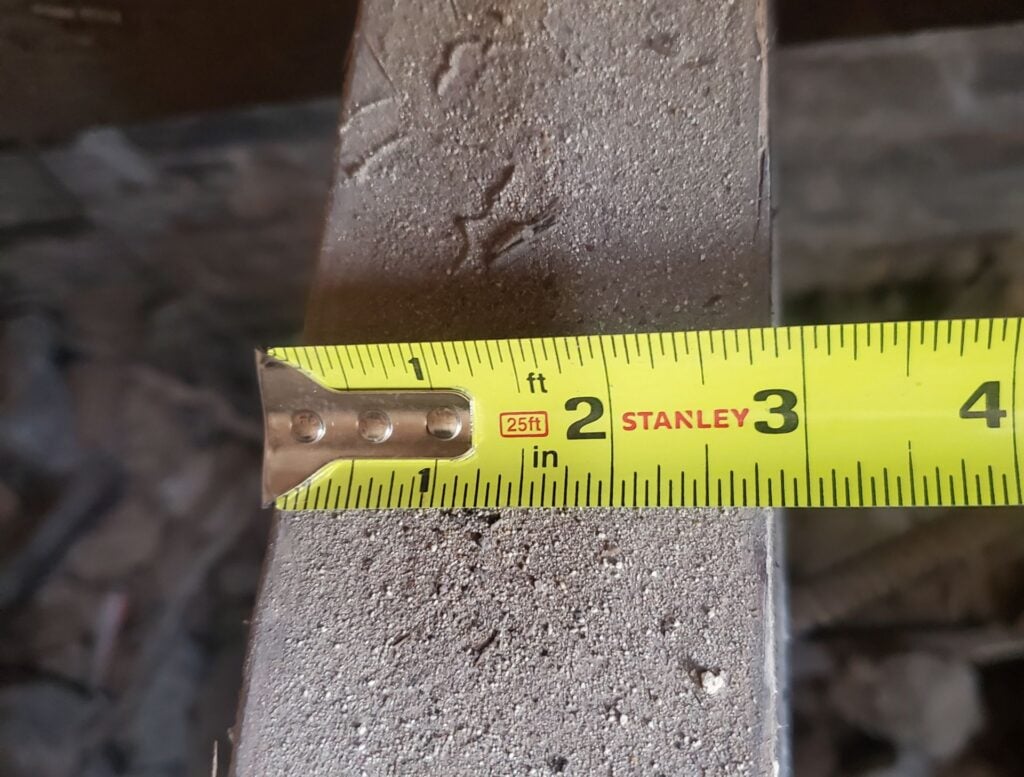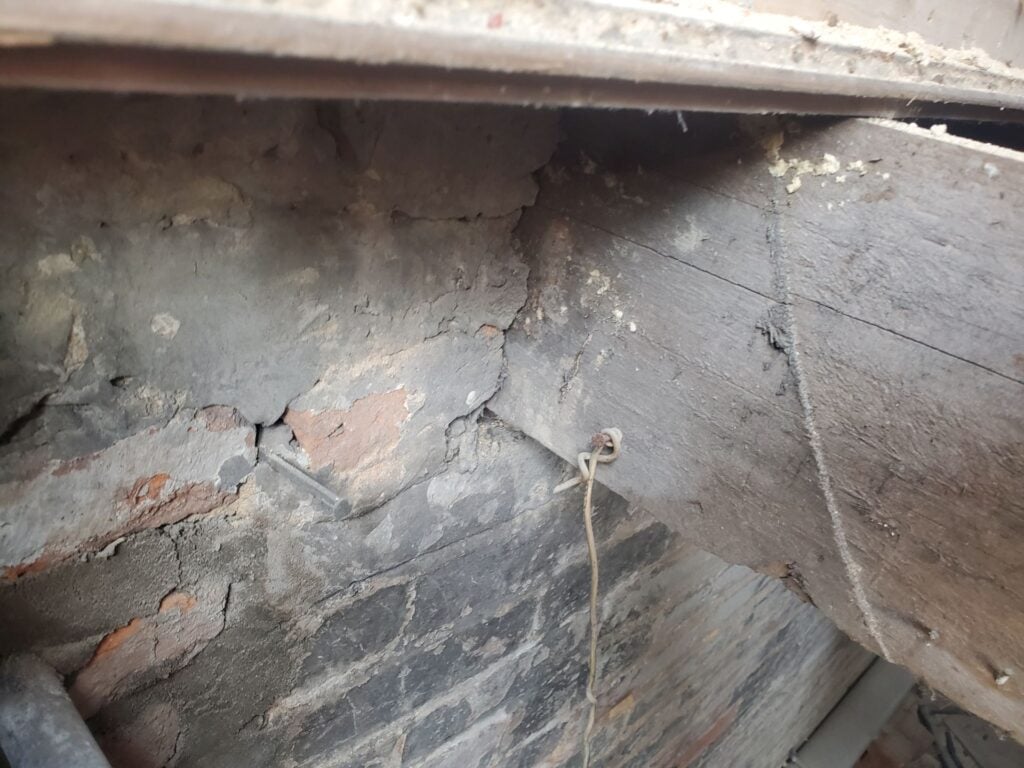This week, we had an opportunity to take a look at a very interesting project where the interior of a historic rowhome has been all but completely removed. This renovation is a full “gut reno”, an extensive demolition and rebuild. However, the existing shell and core of the building remain, this detail is the key difference between a full demolition of a building, essentially razing a building to the ground versus a limited partial ‘gut’ demolition. The terminology is used, as in butchering a carcass, removing the guts takes everything out, such as all the organs on the inside, but leaves the structure and shell in place. The finishes and cladding have all been stripped down including the floor decking and sheathing. When standing on the ground floor, as shown in the photo below, you can see directly up through the upper floors of the building, all the way up to the roof rafters and roof sheathing above, the roof is still in place, but all the framing member materials in between the foundation and crawlspace of building, up to the underside of the roof, remain in place. The structural load path, even after a century, is still in pretty good condition.
Example of a Strong Structural Brick Loadpath
Most modern simple layout type buildings, such as residential homes, are generally built today with a California platform framing method. This type of construction and structural framing methodology became commonplace in the mid 20th century. Balloon framing, used widely in the advent of stick framed Victorian buildings, was a result of steam (and later electric and hydraulic equipment and mills) technology, later largely replaced or superseded by platform framing. However, historic brick buildings such as this particular building were built iin the late 19th century and early 20th century and used a completely different type of building methodology. This historic brick rowhome building and all others of similar type and age of construction were built using the brick demising or partition walls as a structural load path. The floor joists and roof rafters were inserted or mortised directly into the brick demising wall.
Generally speaking, the predecessor to California platform framing was balloon framing, for free standing homes outside of densely built urban centers. However, in a Washington DC rowhome or row building type construction, this type of brick construction was used instead. Platform framing uses a rim joist at each floor level. In some ways, platform framing can be considered more efficient and faster in the construction building process. Platform framing, unlike balloon framing and unlike brick rowhome construction (as shown in the picture below), does a better job to create a fire stop of blocking between levels of a building. Platform framing can be built completely independently of a system of brick and mortar built structural walls. In fact, when we see contemporary or mid 20th century brick facades on free standing homes in the suburbs, those brick cladding elements are usually just applied, almost for little more than decoration. In almost all cases brick has a value in resistance against the spread of fire, but that isn’t the purpose in freestanding contemporary homes.
In historic brick buildings, structural capacity and fire resistance of the brick, was the point. In contrast though, in the contemporary buildings, used as a point of comparison, the brick is actually not even self supporting and definitely not a structural element. Instead brick cladding must be supported by the wood framing, existing as a burden to the structural frame and structural load path of the building.
Historic framing, at the interior of the building, was often built very strong, by modern standards. In this particular case the framing choice, at the floors of the interior of the building were built with a 2.75″ wide joist. Modern framing members, for floors, are often just 1.5″ in width. These modern materials have a much lower structural capacity. However, in modern framing construction, instead of having structural beam pockets, usually with a fire cut technique applied to each end of the joist, structural metal elements are used to provide additional support and structural connectivity to perpendicular framing members. For example, in most cases of modern or contemporary construction where a joist connects to a rim joist or header, a thin pre-formed electro-galvanized steel joist hanger (or hurricane clip in some attachment configurations) is often used.
Generally, and old historic buildings like this, minimal repairs such as brick or masonry restoration such as tuckpointing or repointing can be done to significantly ameliorate and improve the condition of the masonry, essentially extending the lifespan for decades to come. Although modern steel or metal structural connector components are intended for use in new construction, these elements can also be used in several different types of applications to improve the connectivity and strength of existing historic framing members as well.
The next picture below shows the top of a floor joist more closely. You can see that the width of the joist is 2.75″. Compared to contemporary framing members, this particular joist is massive and significantly stronger. Historic framing members were not only generally larger than modern or contemporary framing members, but they were also generally cut from timber that was older growth, therefore stronger due to tighter and more dense growth rings from the trees themselves. The stronger fiber of the wood allows for longer comparative spans with better deflection coefficients. Modern timber harvesting is notorious for using fast growth coniferous wood and harvested or cut comparatively early in the lifespan of the tree or forest. These modern timber harvesting methods are actually often farmed taking wood from areas that have already been cleared, often clear-cut land, causing severe environmental or ecosystem impacts. These factors make modern wood framing members much weaker.
Wood framing members, used in historic buildings were cut and harvested from forest that were virgin or primary growth. Those areas of forest had grown unimpeded from man and had not been clear cut at any point in history.
Beams or joists, like the one shown below, in historic construction where bearing on a masonry beam pocket in a structural demising wall are cut with a fire-cut, an angle at the end of the joist which allows the joist to collapse in the case of a fire without buckling the brick and mortar wall. Without a fire-cut, if a floor system were to collapse, as the joist system falls away from the demising wall, the edge of the joist would force the brick wall above upwards in a moment connection, like a lever. This force could topple the wall, a wall shared between buildings which could in some cases otherwise be protected from the fire next door.
To understand how a collapsing floor system can cause an upward pressure on a brickwall, visualize the vertical height of a joist, when that joist is in a horizontal position, that measurement is a consistent constant, but when that joist dips downward towards the center and pulls away from the masonry beam pocket, the angled height, measured from the bottom of the beam pocket, increases, with the full force of the weight of the floor system. The geometry may sound confusing, but it’s actually very simple. Any diagonal across a square or rectangle is longer than the longest side of side of the square or rectangle. In this case that longer angle is being applied upwards and, resultingly, downwards at the same time but the downward direction of the wall is supported by an underground footing which has significant resistance to force. The upper portion of the wall though is secured by only its own weight. Therefore, in this type of circumstance, without a fire-cut built into the joist end, the specific joists or area of the joist system could literally destabilize and topple the entire brick wall.
Although particular spots or areas of the exterior brick masonry require restoration and repointing or tuckpointing today, much of the interior brick was protected from exterior elements, and is still in decent condition despite its significant age.
To properly maintain, repair, and care for these historic buildings, a knowledge, interest and understanding of historic building principles is required. Here in Washington DC, historic masonry buildings are extremely expensive and the amount of financial loss caused by improper repointing and low quality construction is staggering. However, in addition to the direct financial value of the property, there is also a cultural loss when historic buildings are damaged. By comparison, consider neighboring poor cities, when historic buildings are damaged, it’s not just the loss of value to the property owner, there’s also a loss to all inhabitants and visitors of a city, present and future, who care about architecture, history, and culture.
We encourage all of our clients, and all readers of this article and to our blog in general, to prioritize the historic built environment of Washington DC and neighborhoods such as Capitol Hill, Dupont Circle, and Georgetown and become educated on on the difference between proper historic preservation versus improper work which leads to significant damage to the historic fabric of a building.
From a conservation and preservation perspective, several approaches can be taken to improve conditions related to deteriorated historic brick masonry. Primarily, lime mortar brick joints and low temperature fired soft red clay bricks should be inspected and checked on a routine maintenance schedule, either seasonally or at least annually. If brick masonry is kept in good condition, the life of embedded wood elements can be significantly extended. Hire a professional contractor which specializes, understands and appreciates historic construction elements and buildings.
In this article we talked about the terminology and concepts of historic masonry restoration, follow the links below for more related information from the IDS website:
- Binders in mortars and concrete
- Brick burns
- Butter joint
- Capillary action
- Cantilever
- Cementitious siding
- Cheek wall, masonry — Draft
- Chemical testing
- Code, building — Draft
- Cold joint
- Cold weather masonry work — Draft
- Damp proof course
- Downspout
- Electrical distribution panel — Draft
- Fenestration
- Ferrous metals
- Great Chicago Fire
- Green bricks
- Gutter, roof
- Lime mortar
- Lintel
- Load path
- Oriel window
- Oxidation
- Parapet coping
- Plug, clay
- Pressed bricks
- Raking, of mortar joints
- Raggle, aka reglet
- Rectilinear
- Roman bricks
- Roman arches
- Roof eave
- Roof termination
- Row buildings and row homes
-
- Rubbed bricks
- Rubble stone masonry
- Sand, Builder’s
- Sedimentary rock
- Scratch coat
- Sprung arch
-
- Squint bricks,
- Strike, or striking of mortar
- Tapestry bricks
- Tooth-in, interlocking masonry connections
- Vitreous
- Water diversion systems
- Zipper-joint
These concepts are part of the fundamentals of historic masonry restoration, tuckpointing, and brick repair.
The links in the list above will take you to other articles with more information on defects, failures, preservation and repair of historic masonry. You can learn a lot more on our blog. Feel free to check it out. If you have questions about the historic masonry of your building in Washington DC, contact us or fill out the webform below and drop us a line. We will be in touch if we can help.






